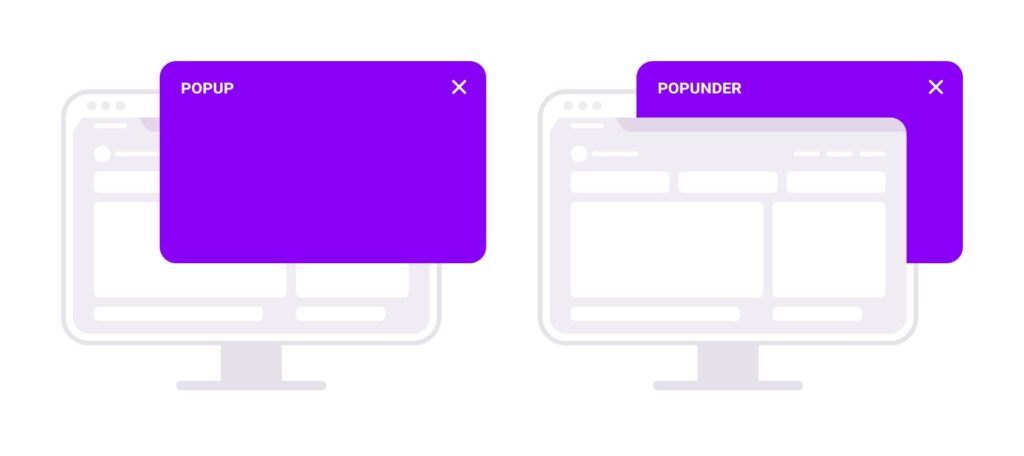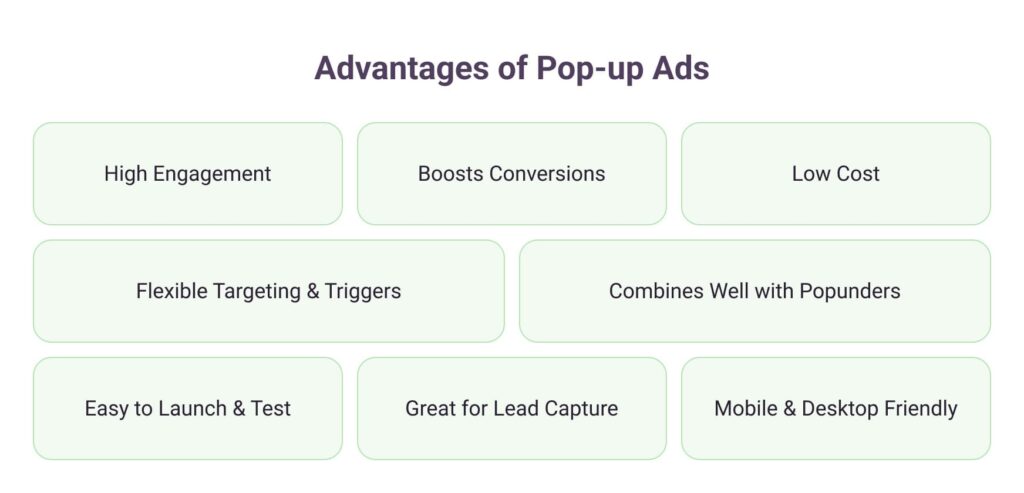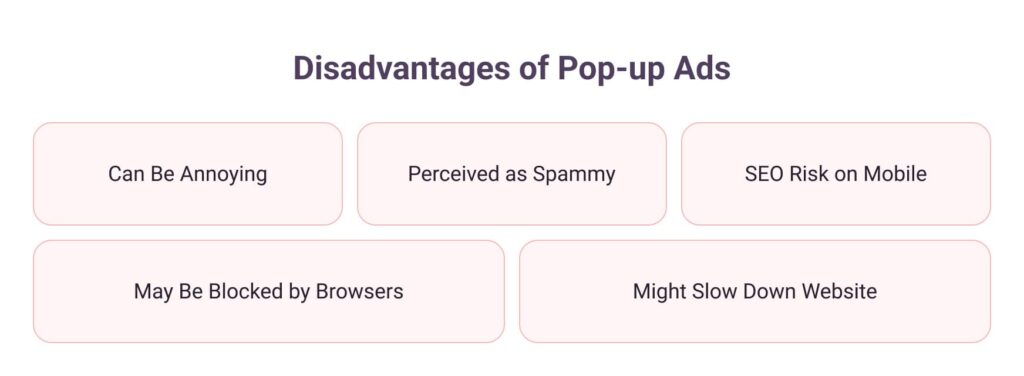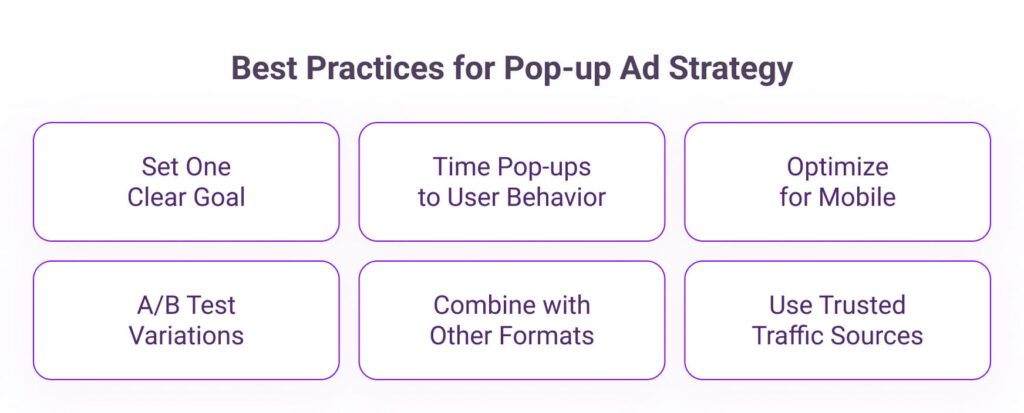Brief content: Pop-up ads are a powerful ad format to grab attention, get leads and boost conversions. Their pros are high visibility, low cost and strong performance when used with smart triggers like exit-intent or scroll-based actions. Cons are annoying users, being blocked by browsers and potential SEO penalties if not mobile-optimized. When done right, pop-up ads are a perfect tool for affiliate marketers, especially when combined with quality traffic and a solid strategy.
Pop-up ads are one of the most debated tools in digital marketing. For some, they’re a quick win — easy to launch and can drive big results. For others, they’re intrusive, outdated and a risk to user experience. The truth is somewhere in the middle.
In affiliate marketing, pop-up ads fall under the broader category of pop traffic, which includes pop-ups and popunders. While popunders open behind the main browser window, pop-ups appear directly in front of the user, immediately grabbing attention.
This article breaks down the pros and cons of pop-up ads, based on real use cases, performance data and current best practices. We’ll look at how pop-ups work, do they increase conversions and are they worth using in 2025. You’ll also find a comparison with popunders, strategy tips and a detailed FAQ at the end.


Roya, Emotional Damage Officer & Supreme AI Arbitragist at ROIads
What Are Pop-up Ads?
Pop-up ads are windows or overlays that appear on a website or landing page, usually triggered by user behavior. Unlike standard banner ads, pop-ups display over the page content, forcing immediate attention. They can have a call-to-action (CTA), a form or a redirect link — making them super popular in lead gen and affiliate marketing.

Pop-up ads are part of the broader pop ads category, which includes two main formats:
- Pop-up Ads — appear in front of the user’s current window.
- Popunder Ads — open in a new browser tab or window, behind the current session.
Knowing the difference helps media buyers decide which to use depending on the goal: aggressive engagement or softer post-session interaction.
Types of Pop-up Triggers
Pop-ups can be triggered by:
- On load — shown as soon as the page loads.
- On scroll — when a user scrolls a certain percentage down.
- On click — when a user clicks a button or link.
- On exit — exit-intent pop-ups detect when a user is about to leave.
- After delay — after a certain time spent on page.
Pop-up vs Popunder: Key Differences
| Feature | Pop-up Ads | Popunder Ads |
| Visibility | Very high – displayed above content | Medium – opens behind current tab |
| User Experience | Can be intrusive if poorly timed | Less disruptive |
| Conversion Potential | High – immediate attention | High – longer session exposure |
| Blocking Risk | Higher – often blocked by browsers | Lower – better delivery rates |
| SEO Risk | Higher if not optimized for mobile | Low |
| Cost on ROIads | From $0.5 CPM | From $0.5 CPM |
Both formats are available on ROIads ad network with full access to premium traffic segments. When paired correctly with vertical-specific strategies (e.g. gambling, dating, sweepstakes, betting), pop-up ads can deliver strong ROI — especially on mobile when well optimized.
✅ Advantages of Pop-up Ads
Despite their controversial reputation, pop-up ads continue to be one of the most effective formats for affiliate marketers — especially when properly targeted and optimized. Below are the key advantages of pop up ads, based on practical usage and campaign results.

1. High Visibility and Engagement
Pop-up ads are displayed right over the content, you can’t ignore them. This gives them a big advantage over static banners or native widgets.
- Perfect for time sensitive offers and aggressive lead capture.
- Great for driving attention to your main CTA.
This format creates instant user engagement, which is key for CPA/CPL funnels.
2. Proven to Increase Conversions
One of the most common questions is: do pop-ups convert?
Yes — if done correctly, they do.
According to updated affiliate case studies, pop-ups with exit intent or scroll triggers show 5-10% conversion rate increase compared to static placements. This makes them a good choice for verticals like dating, utilities, sweepstakes.
3. Easy to Launch and Test
Pop-ups are easy to deploy using scripts, plugins or built-in campaign tools from ad networks like ROIads. Many affiliate marketers choose pop-ups because they allow:
- Quick launch no developer help.
- Easy A/B testing of copy, creatives and triggers.
- Real-time performance adjustments.
You can launch and test multiple variations in one campaign flow.
4. Low Cost, High ROI
Running pop-up traffic via ROIads starts from $0.5 CPM, which is one of the cheapest traffic sources out there.
- Works well for testing low payout offers.
- Helps scale profitable flows without big upfront investment.
Combined with premium traffic, pop-ups can deliver very high ROI even on small budgets.
5. Highly Customizable Display Logic
Pop-ups offer flexibility in how, when and to whom they are displayed:
- Trigger by scroll, click, time, exit intent.
- Target by device, browser, geo or OS.
- Show different versions on mobile and desktop.
This allows marketers to align pop-up logic with campaign goals without hurting UX.
6. Works on Both Desktop and Mobile
Some users ask: “Are pop-ups bad for mobile?”. Modern pop-ups are lightweight and mobile-optimized.
- Use mobile-friendly designs to avoid Google penalties.
- On ROIads, premium mobile traffic performs well for iGaming, dating.
- Mobile specific creatives increase CTR.
7. Great for Subscription
If you want to build an email list or collect user info, pop-ups are one of the top tools.
- Use gated content, discount offers or exit coupons.
- Combine with short forms for max conversion.
This makes them perfect for SaaS, e-com and info product funnels.
8. Works Well with Other Formats
Pop-ups don’t have to work alone. On ROIads ad network, affiliates often combine pop-up and popunder ads in a single campaign to maximize reach and conversion at every touchpoint.
- Pop-up = immediate engagement
- Popunder = softer follow-up offer or redirect
Together, they support multiple conversion paths in one flow.
❌ Disadvantages of Pop-up Ads
Despite their effectiveness, pop-up ads come with certain risks. Many media buyers wonder about the disadvantages of pop up ads, especially regarding user experience and long-term performance. Below are the most common concerns — and what you should know before launching.

1. Pop-ups Can Be Annoying
It’s no secret: many users find pop-ups annoying. When pop-ups appear too frequently or cover the main content, they can cause frustration and high bounce rates.
- Especially true on mobile if not optimized.
- Intrusive formats = poor first impression.
But this is mostly a strategy issue, not a format flaw. Proper timing (e.g., scroll or exit-intent) significantly reduces annoyance.
2. May Be Blocked by Browsers or Extensions
Modern browsers and adblockers actively block aggressive or spammy pop-ups. If your script isn’t compliant, your ad simply won’t show.
- Chrome, Safari, and Firefox have built-in blocking rules.
- Mobile browsers tend to be more restrictive.
But most ad networks (including ROIads) ensure ad formats are optimized for maximum deliverability, even under stricter conditions.
3. Perceived as Spammy or Distrustful
Poorly designed or irrelevant pop-ups can make your site look untrustworthy. Users are quick to close anything that feels like spam or malware.
- Overuse = loss of credibility.
- Inconsistent creatives = drop in trust.
Use clean design, strong value propositions, and consistent messaging to avoid this problem.
4. SEO Penalties (on Mobile)
A key concern: can pop-up ads harm SEO?
Answer: yes, if they block the main content on mobile.
Google’s interstitial guidelines penalize intrusive pop-ups that degrade mobile user experience. But this only applies to specific use cases, not all pop-ups.
- Avoid full-screen mobile overlays.
- Use delay or scroll-based triggers instead.With proper implementation, you can run pop-up ads without harming organic visibility.
5. Can Slow Down Website Performance
Another common issue: do pop-up ads slow down a website?
Yes — if you use multiple heavy scripts, unoptimized images, or outdated plugins.
- Long loading times = lower engagement.
- Poor Core Web Vitals can affect ranking and conversion.
Best Practices for Pop-up Ad Strategy
Even the best ad format won’t perform without the right strategy. If you want to maximize the benefits of pop up ads while minimizing the risks, follow these proven approaches used by top affiliate marketers and advertisers.

1. Set a Goal Before You Launch
Every pop-up should have one clear purpose: lead generation, redirect, exit recovery, or subscription. Don’t try to do multiple things at once.
- Define your conversion goal before setting triggers.
- Align design and messaging to that single objective.
2. Match Display Timing to User Behavior
Don’t just show a pop-up on page load and hope for the best. Instead:
- Use exit-intent for bounce prevention.
- Use time-delay after 10–15 seconds to avoid disruption.
- Use scroll-based pop-ups to target engaged users.
Proper display logic matters for conversions and user experience.
3. Optimize for Mobile
Mobile traffic is huge — but poorly optimized pop-ups are the fastest way to lose it.
- Use responsive design and light pop-up scripts.
- Avoid content-blocking overlays.
- Test on real devices to check UX and load speed.
Google penalizes intrusive pop-ups on mobile — so always test and adapt.
4. Test Multiple Variations
Pop-ups support fast iteration. Use that to your advantage:
- A/B test copy, CTA, layout, and trigger type.
- Measure micro-conversions like button clicks or scroll depth.
- Track bounce rates for each variation.
Successful campaigns often test 5+ variations before finding a winner.
5. Combine Pop-ups with Other Formats
Pop-ups work great alone, but even better with popunder traffic. This multi-format approach creates multiple user touchpoints, increasing conversion chance.
- Example: Pop-up for first attention + Popunder with deep funnel offer.
- Especially effective in verticals like dating, gambling, sweepstakes.
6. Use Trusted Traffic Sources Only
Bad traffic = bad results, no matter how good your pop-up is.
👉 Why ROIads Is a Smart Choice for Pop-up Campaigns
If you’re serious about running high-ROI campaigns with pop traffic, ROIads is one of the best platforms available:
- Supports both pop-up and popunder formats, with premium traffic only. Also, push format is available.
- Advanced targeting: device, OS, geo, browser, connection type, device, browser language, schedule, and more.
- Full access to publisher- and source-level stats — perfect for Micro bidding.
- AI bidding technology + CPA Goal.
- Starting price: $0.5 CPM — perfect for scaling or testing offers.
- Ultra-fast moderation and full support for Keitaro, Voluum, BeMob, RedTrack trackers.
- Dedicated manager for deposits over $500 (with help on creatives and setup).
Whether your goal is lead gen, soft redirect or form submission, ROIads pop traffic delivers stable volume, clean user flow and conversion-ready traffic in over 150+ geos.
Are Pop-ups Good or Bad?
The pop-up debate often boils down to one question: Are pop-ups good or bad?
The answer is: it depends on how you use them.
👍 When Pop-ups Are Good
Pop-ups are good when they have a clear strategy, respect the user’s session and are designed for one goal.
- They engage when triggered by real behavior (e.g. exit, scroll, delay).
- They convert when paired with a relevant CTA.
- They’re easy to test and adjust, so you can optimize fast.
With good traffic and clean execution, pop-ups can be one of your top affiliate tools.
👎 When Pop-ups Go Bad
Pop-ups go bad when:
- They’re intrusive or irrelevant.
- Annoying on mobile (e.g., covering content or blocking navigation).
- No clear message.
- Spammy in appearance (bad visuals, fake timers, clickbait).
In these cases they hurt user experience, damage trust and increase bounce rates.
The Verdict: Pop-ups Are Good — With the Right Setup
Pop-ups are good — highly effective. They don’t have to be disruptive or spammy. In fact some of the highest converting affiliate campaigns today use pop-ups as their main entry point for capturing user attention.
The key is execution:
- Clear goal
- Smart timing
- Mobile-first display
- High quality traffic (e.g., from ROIads)
- Continuous testing
Done right pop-up ads improve performance without hurting UX or SEO.
Pros and Cons of Using Pop-ups
Here’s a side-by-side summary of the main pros and cons of pop up ads — especially for advertisers and affiliate marketers considering this format in 2025.
| ✅ Pros | ❌ Cons |
| High visibility — shown above content; grabs user instantly | Can be annoying if poorly timed or irrelevant |
| Improves engagement and conversions, especially with smart triggers | Blocked by some browsers or extensions |
| Cost-effective — low CPM rates on ROIads | Risk of looking spammy if design/copy is poor |
| Easy to implement via script or direct link (no plugin needed) | May harm SEO on mobile if content is hidden |
| Customizable strategy — by scroll, exit, delay, click | May slow down page if poorly optimized |
| Mobile-ready with responsive design | Requires testing to avoid bad UX |
| Great for subscriptions, lead gen, and CPL goals | Not suitable for all verticals or sensitive niches |
| Works well with other formats, e.g., popunders | Needs careful messaging to avoid trust issues |
| Backed by performance data — used in high-ROI affiliate campaigns | Not effective if run on low-quality or irrelevant traffic |
The table shows: while there are real cons of pop up ads, most of them are solvable with smart campaign design, quality traffic and testing. When done right, pop-ups are one of the most effective ad formats for 2025.
Conclusion: Should You Use Pop-ups on Your Website
Despite being labeled by some as outdated or annoying, pop-up ads still deliver when:
- Displayed based on user behavior (exit intent, delay, scroll)
- Optimized for mobile
- Matched to user expectations and campaign goals
- Backed by high quality, clean premium traffic
Studies and real world tests show pop-ups convert when designed and triggered smartly.
When to Avoid Them
- If your page has high bounce rates, test carefully.
- If your niche is sensitive (e.g., finance or medical) use soft triggers.
- If your offer doesn’t match the urgency or value for an interruptive format use popunders instead.
💡 Final Tip: To get the most out of pop-up campaigns, run them on platforms that offer:
- Transparent traffic sources
- Publisher-level stats
- Advanced targeting tools
- Proven performance in your vertical
ROIads checks all those boxes — and gives you full control over delivery, audience, and optimization.
Pop-ups are not just alive — they’re still one of the most powerful tools in affiliate marketing. Use them smartly, and they can help you hit your performance goals faster than any static banner ever could.
FAQ: Pop-up Ads Advantages and Disadvantages: What to Know
❓ Do pop-up ads improve conversions?
Yes, especially with exit intent, scroll-based triggers, or timed delays. Pop-ups can convert 5–10% or more when well targeted and aligned with user behavior.
❓ Are pop-up ads annoying?
They can be — if used wrong. But with proper timing, clean design, and mobile optimization, most users won’t find them intrusive. Irrelevant or aggressive pop-ups are what make the format annoying.
❓ Can pop-up ads harm SEO?
Only on mobile, and only if the pop-up blocks core content. To stay SEO-safe:
- Don’t use full-screen overlays on mobile
- Use non-intrusive triggers like exit intent
- Follow Google’s interstitial ad guidelines
❓ Are pop-up ads still effective?
Absolutely. Pop-ups are still one of the most effective formats for lead capture, engagement, and CPA funnels — especially on premium traffic sources like ROIads.
❓ Do pop-up ads slow down a website?
They can, but only if:
- You’re using heavy scripts or outdated plugins
- The pop-up loads unnecessary third-party assets
Modern implementations are lightweight and fast. Always test your load speed after adding pop-up logic.










